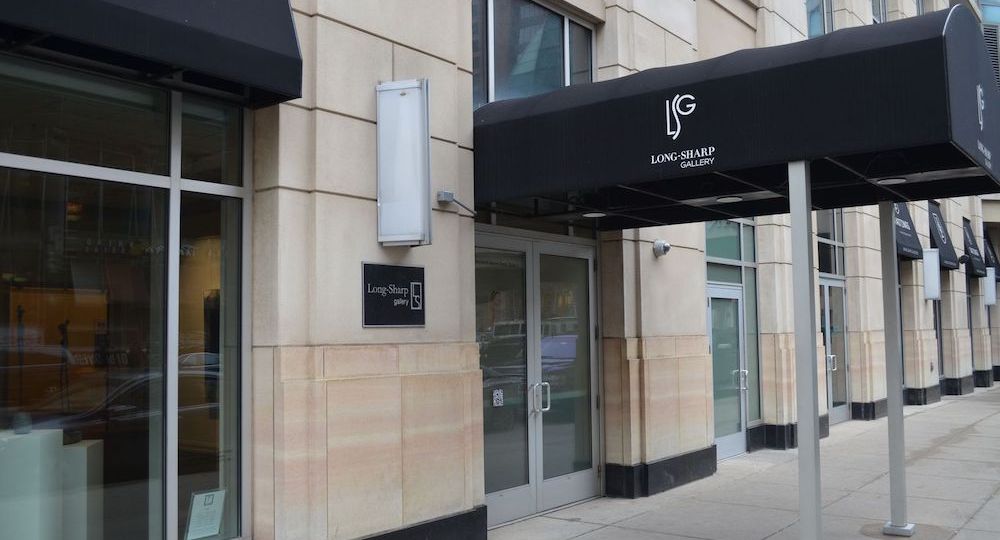
This story was created in partnership with Long-Sharp Gallery

One of the very first events I attended a few years ago after moving back to Indianapolis after years living in New York was at the Long-Sharp Gallery located on Illinois Street in Downtown Indy. Now, I can’t remember which artist was being featured (oops!) but I knew I was in a happy and unpretentious place sipping on a glass of wine and talking about modern and contemporary art.
Over the years, the Long-Sharp Gallery has been home to many a name that you don’t need a degree in art history to recognize: Picasso, Warhol, Haring, Indiana, Lichtenstein, just to name a few. It has truly become a beacon for modern art loving Hoosiers and represents a number of artists including Tarik Currimbhoy, Cha Jong Rye, Dale Enochs, Jason Myers, Sabina Klein, Amy Kirchner, and Patrick Hurst. The gallery’s team also curates the “Art Stays Here” program at the Conrad Indianapolis.
Their influence is vast—and so important to our own community.
We chatted with owner, and former attorney, Rhonda Long-Sharp about her absolutely fascinating career and the great team around her that makes the gallery an important fixture in not only the local art scene, but the national and international ones as well.
Tell us a bit about how you came to a career in art and how the gallery came to be. Did you always know you wanted to work in the art world?
My overarching career goals have been to:
1) Sing back-up for Aretha Franklin
2) Bring fundamental fairness to the criminal justice system
3) Be involved in the visual arts
If you heard me sing, you’d know why #1 was not going to happen, ever.
I never expected to have a career in the arts. This, despite the fact that around age 4 or 5 I announced to my father that I planned to be an artist, a horse trainer, or a professional majorette. I remember him clearly telling me on more than one occasion that I was never going to get to the “other side of the tracks” because of my love of art. He did not want to see paint in my hands; he needed to see a math book instead.
I practiced law for around twenty-two years and during that time defended men and women on death row in the US at every stage of the process: trial, appeal, post-conviction, federal district and appeals courts, and in the Supreme Court of the United States. It felt right doing this—giving a voice to people caught up in a system that was not built to handle the frailties of humans.
On the most difficult days, art kept me sane…well, relatively sane. An abstract painting by Lois Main Templeton or Mary Lou Dooley Waller would give my mind the rest it needed and the wonder of the beauty created by these amazing women never failed me.
But after a few decades, I’d seen too much and I found myself saying “no” to additional capital cases. It was at then that I found myself with a few spare hours here and there; this was something I was unaccustomed to.
I used the time to learn more about some of the art my husband and I purchased—works by Joan Miró, Salvador Dali, or Pablo Picasso. My research led me to conclude that the purchases we made from galleries outside Indianapolis, while expensive, were likely worthless or certainly worth far-less than we paid for them. Plane trips, phone calls, and lots of reading ensued. I was used to investigating. This felt comfortable. And, it was challenging. The end result, however, left me bereft and angry. I was ashamed at how foolish and gullible I’d been in making these now-troubling “fine art purchases.” These investigations spurred seeds to take root.
As my legal career came to a close, my view of humanity was dim and my hopes for fairness in the criminal justice system were shattered. Rather twistedly fortunate, a concussion abruptly ended my legal practice and as I recovered, I had time to consider next steps.
One step I took was facing the entities that sold me (for lack of a better word) the “bad art.” The more I learned, the more compelled I became to push back and champion the novice collector and genuine art lover.
With each new chapter, it became more and more apparent that all galleries and auction houses are not created equal. The art business is an unregulated one, and it is only as good as the integrity of the people in it. There is no “Carfax” for fine art. And, the more I learned, the more I felt a need to share it with art lovers like myself who would or had fallen prey to the underbelly of the fine art world. And so it began.
One thing has led to another, it seems. There was no “grand plan” in the beginning. But once I decided to open a gallery downtown, I decided it was going to be one heck of a gallery. One with a vibrant and dynamic program, one with Indiana artists shown alongside masters, one with a roster of contemporary artists outside of the region, and one that spoke to an upper level of art and art connoisseurship in Indianapolis.
So what are you and your team looking for in artists you exhibit and/or represent?

One of our gallery’s tenets is that we have to show art that we love. I’m an art collector first, gallery owner second. And, the business is investing its resources in each artist. Rachel, Nicole, and I have to be 110 percent behind the art and the artist.
When it comes to the blue chip side, we own our inventory. We buy all over the world. My theory, once more, is that we buy what we like. If no one else buys it, we get to keep it. The key is buying authentic, great condition, blue chip artwork.
How do you seek out and discover new talent? What excites you most in finding a new artist or starting to work with someone whose work you’ve long loved?
I am a fan of British Pop artist David Spiller. Several years ago, while exhibiting at Masterpiece London, he and his wife Moira walked into our stand. I saw the Beatles once…it was something like that.
One thing led to another and David and Moira invited us to their home for lunch that weekend. There was a painting of his I’d seen about 10 years before in an art magazine that I’d never quite gotten out of my mind. It took me an hour to finally ask if he remembered it, and whether he happened to know who presently owned it. He disappeared for a bit and later directed me downstairs to his studio where the giant painting I asked about was leaning up against a wall.
We represented David in the United States for several years before he died. We now represent his estate. A year after we met, that giant painting showed up at my doorstep and to this day hangs in my home.
The talent these artists possess is mind-boggling. David’s paintings bring me joy. That one person can give that joy to another is nothing short of miraculous. David used to say he just wanted to put some “magic on the wall.” Great artists can do that. Being a part of that magic, being able to experience it, is a privilege.
What are some things that people might not know about the work you do and what you bring to the community?
We are a top-tier gallery by any standard one chooses to employ. We’ve been selected as one of the top galleries in the world quite a few times. We are members of the International Fine Print Dealers Association (the preeminent organization for galleries handling prints)—this organization is a “big deal” in the fine art world and it is not easy to get into.
Our clients consist of museums (including the “big names” in this country), worldwide corporations, and some of the most important collectors on the planet. They seek us out when they want to buy authentic works by Andy Warhol, Pablo Picasso, Roy Lichtenstein, etc.
All of this to say that, although the gallery has a reputation for excellence outside of Indianapolis, many Indy residents may not be aware of it.
RELATED: MEET THE WOMAN BEHIND INTERNATIONALLY KNOWN KUABA GALLERY IN CARMEL
Talk about your view of the arts scene in Indy and where you see Long-Sharp fitting into it, both now and how it’s evolved over the years.
I remember walking up and down Mass Ave. when I first moved to Indy in the mid-1980s. There were great galleries there. I would walk into Mark Ruschman’s gallery and see works by Andy Warhol, Judy Pfaff, or Tamar Kander. Those days are gone, but they meant a great deal to me.
The arts scene in Indy right now is perilous. The pandemic hurt the arts so very much. Indianapolis’ art scene is predominantly built on a not-for-profit landscape; our gallery is therefore somewhat of an outlier. (The majority of our business is not in Indianapolis. About 35 percent of our business is in the UK and Europe, with the balance in the U.S. Of our U.S. business, less than 5 percent is in Indianapolis.)
We strive to up the art cache in Indy. About five years ago we were exhibiting in London and someone told us of this fascinating Picasso exhibit he saw in Indianapolis at a “hotel” and how surprised he was that it was there—it was our exhibit at Conrad Indianapolis. This is what we are striving for. This is home.
I don’t know if Long-Sharp Gallery “fits in” in Indy—we’ve been in business 15 years now and the gallery has been open for 11. As just stated, we’re sort of an anomaly. Every year I wonder whether we’ll be here the next…but every year, we open our doors with new exhibits better than the last.
What are the trends in art that are exciting to you right now and what do you see on the horizon?
Museums and other institutions are becoming more intentional about the artworks in their collections—about making sure those collections are representational of their communities and of the world. It is an exciting time in that way. A trip to the museum today should be very different than it was 15 years ago.
What do you have coming up that our readers should know about?
In addition to some amazing virtual exhibitions, we have two exhibitions planned for the remainder of the year in our Indy gallery. An exhibition of never-before-seen Andy Warhol works will open on August 6th—Warhol’s birthday, no less. The exhibit highlights Warhol’s drawings from the 1950s, from fashion to advertising to portraiture. It will be open in the gallery through September. An exhibit of Warhol’s photography will accompany the exhibit, though the photography will be in Conrad Indianapolis.
In October, we’re thrilled for the first gallery exhibition of works by Spiller + Cameron. This mother-and-son duo is based in the United Kingdom, and we will be shipping in crates of their new works for the exhibit. Their new work rocks my world.
Visit the Long-Sharp Gallery at 1 N. Illinois St., Suite A in Indianapolis or check out the virtual gallery of exhibits here.
Abby Gardner is Indy Maven’s executive editor, who interned Interview magazine—founded by Andy Warhol—when she was in college.
All of our content—including this article—is completely free. However, we’d love if you would please consider supporting our journalism with an Indy Maven membership.












